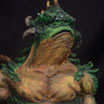The top half of my back still needs some work but I want to move on to the lower back to try and pull all the shapes together. I’m going to need to start working on the right half of the back pretty soon to make sure that all the shapes are coming together correctly. Once I sculpt the right half I should get a good idea if any of the individual shapes need to be reworked.
For this step I’m sculpting the muscles and skin folds that make up the lower back. Again using a loop too I carve out the areas individual muscles. If I carve away too much I can always go back and add little bits of clay here and there but since the lower back already has too much clay I can carve away the shapes for the folds of skin (and muscles). Read the rest of this entry »

 Well, I’m definitely not perfect and I am also not afraid to show my mistakes. I do learn a lot from my mistakes and I think posting them on this site also helps others learn as well. If you have been following the tutorials on this site for awhile then you may remember me mentioning that you need to be careful when bulking out a sculpture to aluminum foil. Well, now you are about to get a good example on why I said that.
Well, I’m definitely not perfect and I am also not afraid to show my mistakes. I do learn a lot from my mistakes and I think posting them on this site also helps others learn as well. If you have been following the tutorials on this site for awhile then you may remember me mentioning that you need to be careful when bulking out a sculpture to aluminum foil. Well, now you are about to get a good example on why I said that. 











